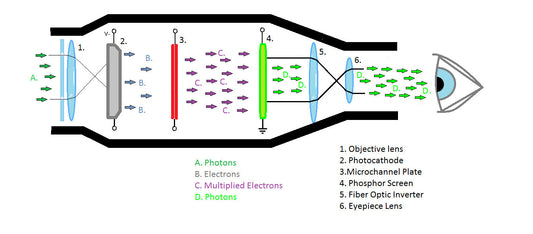Gen.3+ : this is still the Generation 3 but it has significant improvements like for example a truly outstanding performance in urban environments, a resolution of 64-72lp/mm and a typical signal to noise ratio of 26.
Equipment with Gen.3+ thin filmed image intensifier tubes minimizes any halo effect which is often related with using night vision devices in the areas where random street lights are often a complication with earlier generations of Night Vision devices.
Gen.4 On the night vision's market there are several companies that claim to sell devices Generation 4 as supposedly the most advanced night vision devices you can buy, where removing the ION film actually allows more electrons to reach the amplification stage so that the images are significantly less distorted and brighter.
It is difficult to say whether it is a myth or just an advertising trick, but devices currently sold as Generation 4 are truly Generation 3 devices.
If you read the Gen.4 image intensifier tube's features you can easily see that there is Gallium Arsenide photocatode, resolution of 64-72 lp/mm and a typical signal to noise ratio from 25 to 30. These are the parameters of Generation 3+.
Historically the United States Army has defined each Generation of night vision and there are four Generations of night vision, however, they are generations from Gen.0 to Gen.3, not from Gen.1 to Gen.4.
After 1990 the Army defined Gen.4 as the filmless and gated technology which shows significant overall improvement in both: low level and high level light environments. The advancement had to increase resolution, sensitivity and signal-to-noise ratio for overall improved performance, and reduce halo effect. Unfortunately the lack of an ION barrier in Gen.4 tubes led to high failure rates. Therefore United States Army had to abrogate the existence of Gen 4 definition.
Due the high failure rates of Gen.4 technology, Generation 3 have been modernized by creating a thin filmed tube.
Finally when the thickness of the film has been reduced and protective ION barrier has been preserved, the innovation resulted in the production of the Gen.3 thin filmed tube, which is now the highest performing Generation 3 tube available on the market. It is often called the Gen.3+ and provides performance requirements intended for Gen.4.
Of course, tubes called Generation 4 are still available on the market, but please be aware that buying these technologies you buy filmless equipment with high failure rate. Sometimes unknowingly you can get devices with thin filmed image intensifier tubes Gen.3+ as filmless devices Gen.4.
What next? One of Las Vegas based companies has developed a revolutionary night vision sensor. The ultra sensitive sensor is able to shoot a full color night vision images. Despite the fact that the company claims to have military grade day/night imaging system, this technology is still imperfect.
For objects' backlighting the system uses several powerful IR lasers in different colors so the user of the device is visible from a great distance like a disco dance floor. Powerful lasers moving in different directions are also very dangerous to the eyes of others in the range of the device.
Therefore this technology needs several more years to fully develop.

